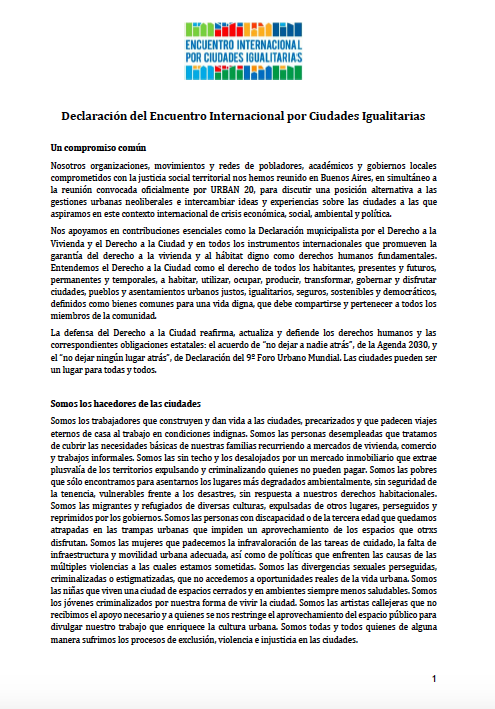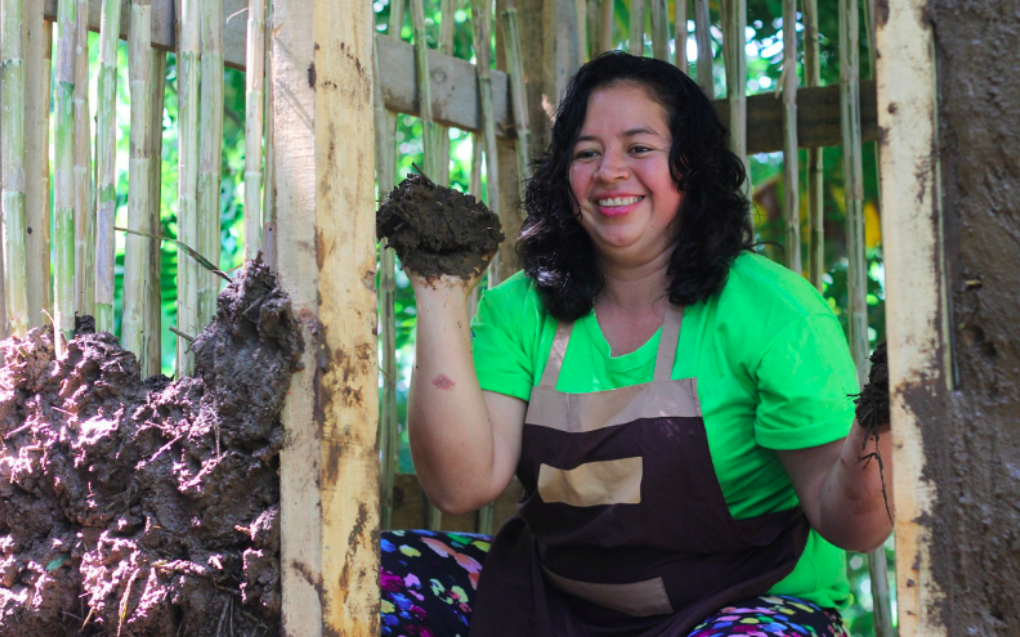1.- History, background and context
Project work in the Ampliacion Hidalgo Neighbourhood in Minatitlan, Veracruz began more than 15 years ago and grew out of the joint efforts of two organizations: the UCISV-VER and the Grass-roots Ecclesiastical Communities. The Grass-roots Ecclesiastical Communities was founded by a priest called Modest Juarez Delgado who started a women’s organization as a result of his reflections on the structural causes of poverty, and particularly of illness. From this the women’s promotion group was formed which was oriented initially towards training for health promotion and the struggle for improving the quality of life on the periphery of the Minatitlan Municipality and particularly to urban improvements.
The Ampliacion Hidalgo and the Hidalgo Neighbourhood, in which the project has been developed, have a total population of approximately 3,000 inhabitants. These neighbourhoods do not have all the essential urban infrastructure and services. The supply of potable water and electricity are deficient, there is no drainage system and 60% of the housing is precarious. In general, the families are large and the majority are migrants from the rural areas who are looking for work in the oil industry. However, the energy crisis has substantially changed conditions for this population and this is leading to migratory flows to northern Mexico and the U.S.A. Employment in the neighbourhoods is generally in the building industry, domestic work and sub-employment in “informal” commerce.
In 1989 the group of women took on their first struggle to close the municipal rubbish dump that was located next to their neighbourhood and was therefore generating public health problems mainly in the form of skin conditions and gastro-intestinal illness.
The organization that arose and the social pressure generated by the group was effective and the rubbish dump was closed. The victory increased the confidence of the group and the rest of the inhabitants of the neighbourhoods who began to work for other improvements such as land regulation, the installation of public services and to have a place that is destined for community projects and where popular health issues could be developed.
In October 1992 the Minatitlan City Authorities granted a 20 x 30 plot of land to the group and their social and organizational work has been centralized in this space since then. The strategy for obtaining support to construct the Popular Health Centre was elaborated from here as well being the organizational centre for carrying out it out. It is thanks to the determination of the group, their organizational capacity, their spiritual strength, their ability for follow-up issues and for management, and the social network that has been constructed around them, that the Centre exists today. It is not only as a building where services are imparted, but has the capacity to generate other projects that, together, represent an integrated approach to community development. This includes housing construction and improvement, productive projects, the management of basic services, and more recently, the Ecological Park.
The social influence of this group of women has been extended to other communities where organizational processes are being developed, and the training of community development agents, which at the same time, leads to the possibility of having an influence in the local political agenda.
2.- Objectives, strategies and scope
General objective:
The creation of a physical space for integrated and self-managing health resources, and a focal point for participation in community development for the neighbourhoods located in the south of the city of Minatitlan in the state of Veracruz.
Specific objectives:
* Training of popular health workers.
* Integral attention for health that is oriented mainly towards women and children.
*Promote and organize the community to achieve improved living conditions including their habitat, their incomes and the sustainable use of natural resources in the zone.
Strategic criteria:
The strategy adopted by UCISV-VER and other groups that have been influenced by it is based mainly on community self-management and the promotion and development of the capabilities of its members through technical, social and political training.
However, there are two aspects of the experience that should be emphasized: on the one hand it has been initiated by a group of women that have developed a female-oriented project, and on the other, the relation between them and the Grass-roots Ecclesiastical Communities, which has enabled and strengthened a strongly socially focused project and this underlies its constant progress.
The initial formation of the group as health workers was developed as an inherent aspect of community work, and efforts were concentrated on the construction, installation and operation of the Health Centre that has enabled its articulation with the community and its different needs.
Several projects have evolved from this starting point and the following stand out for their importance and impact:
* The training of health workers (24 first class workers).
* The construction of dry toilets (20 dry toilets).
* Housing construction and housing improvements (15 houses by self-construction methods).
* The construction of the Community Centre.
* The operation of productive projects (3 projects in operation).
* The elaboration of the Ecological Park project.
Additionally, the formation of links with other civil organizations has contributed to the development of the work. In this sense, the participation of PRODUSSEP and CREO, A.C., who trained the group of health workers, has been essential to the success of the project.
3.- Actors that have been involved in the project and their role in its development
UCISV-VER: social organization whose mission is to promote community organization in general and specifically in the low-income communities of Veracruz in order that their habitat is fair, democratic and sustainable. The UCISV-VER leadership is female as are the majority of its members.
Group of women that promoted the Health Centre: active members of UCISV-VER organization that initiated, designed and implemented the project and ensured its regular evaluation.
Grass-roots Ecclesiastical Communities: an organization that reflects on social conditions and the commitment of Christians to the community.
PRODUSSEP: network of civil organizations for the promotion and development of Popular Health and support for the training of health workers.
CREO A.C.: civil organization for technical assistance and health training.
Project Fund, Canadian Embassy: financing for the construction of the first stage of the Health Centre.
Housing and Urban Studies Centre, A.C.: civil organization that designed the Health Centre.
Habitat for Humanity: financing for housing construction.
Demos I.A.P.: Mexican public assistance institution. Financing for the Environmental and Health Program.
Social Development Secretariat: financing through the Co-investment Program 2000 for the institutional strengthening of the Health Centre. In 2001 Co-investment Program for the financing of the enlargement of the Heath Centre.
Agriculture and Fishing Development Secretariat: financing for the installation of a corn flour mill.
Municipal Government: financing for pavements and roads through branch 033 of the Mexican Federation.
Mexican National Autonomous University (UNAM), Architecture Faculty: elaboration of design proposals for the Ecology Park for the neighbourhood.
NOVIB: Dutch agency for Development Cooperation. Financing for the Training Project for Ecology and Health (1996, 1997).
4.- Project Components (brief description and articulation between them)
The diverse activities of the Health Centre have led to the training of 15 health workers who have organized its integral and self-managing program that includes health attention, training of health workers, pharmacy services and the development of other, equally important activities that include the management of basic services, housing construction and improvement, the setting-up and running of micro enterprises, generating economic resources to sustain the Health Centre, and other responsibilities in connection with the Ecclesiastical Communities (raffles, sale of food, etc).
The self-management of habitat and the relationships between its elements require social organization, training and giving priority to collective organization. All these components are important for the activities related to construction processes and those oriented to resolving social and economic problems.
The focus on the environment and on gender are integrated into all the project activities. It is worth mentioning that, as in other experiences, it very important that they are publicized, valued and promoted in workshops, particularly among groups of women.
5.- Achievements and main lessons that have been learnt
P The consolidation of a group of 15 women that are committed to the project.
P The construction and operation of the Health Centre, not only in terms of consultancy services (120 patients each month), but also as a socio-organizational reference point for the problems that are present in the neighbourhood.
P The influence of the group in other urban communities as well as rural and indigenous zones.
P The resolution of housing and urban problems in the neighbourhood from an integral perspective.
Difficulties encountered in the operation of the program
The main difficulties in the operation of the program are the following:
a) Economic: the search for ways to generate resources has been a major activity for the group of women during the entire experience of the project. The first external financial support came in 1997-1998 with support from the Canadian Embassy and later SEDESOL, for the operation of the Health Centre
In this sense the project has proved its financial sustainability without depending on external resources and has also proved that it can attract them.
b) Politics: the transcendence and impact of the socially oriented work carried out by the womens health group has led to it influencing local politics. However, its relation with party politics is not always the way forward as political interests and a political perspective dominate in political parties. At present the discussion is around the processes that are necessary to build mutual respect, tolerance and diversity with a range of social actors and/or political parties, in order to ensure wider participation in decision-making at the political level in the neighbourhood.
6- Key words:
Mexico, Veracruz, Minatitlan, social production of habitat, housing, organizing for self-management, the role of women, Grass-roots Ecclesiastical Communities, integral perspectives for urban improvements, training, community development, cultural change.
7.- Sources:
– Almazan Cristina, La Casa de Salud Popular, un espacio de desarrollo comunitario en la Col. Hidalgo, Minatitlan 1977. Photocopy.
– Castillo Aurora, Con las manos en la calle, la experiencia del trabajo de mujeres de Minatitlan, 1999. Video
8.- Contacts:
Union de Colonos, Inquilinos y Solicitantes de Vivienda
UCISV-VER, Poblador@s A.C.
Cristina Almazan Villalobos
Circuito Presidentes N 62, Colonia Emiliano Zapata
CP 91090 Xalapa
Veracruz, Mxico
Tel/Fax: (52-228) 8419306
e-mail: cristinaalmazan@hotmail.com – pobladoresac@hotmail.com




